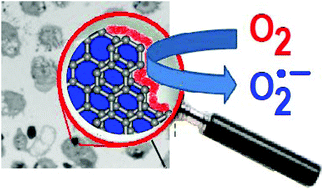Graphite particles induce ROS formation in cell free systems and human cells†
Abstract
It is commonly accepted that the toxicity of carbonaceous particulate matter (PM) is due to the production of reactive oxygen species (ROS) which induce biological damage in the exposed cells. It is also known that PM produced during the combustion processes consists of a carbonaceous core “dressed” with other organic and/or inorganic materials. In spite of this knowledge, the role of these materials in the production of ROS has not yet been clear. This work aims at understanding whether “naked” carbonaceous particles are capable of forming ROS either in cell-free or in-cell systems. The problem has been treated based on the data collected from pure graphite samples of different sizes obtained by ball-milling pure graphite for various lengths of time. The experimental approach considered Raman, ESR (spin trapping), cell viability and fluorescence spectroscopy measurements. These techniques allowed us to carry out measurements both in cell and cell-free systems and the results consistently indicate that also pure naked carbonaceous particles can catalyze the electron transfer that produces superoxide ions. The process depends on the particle size and enlightens the role of the edges of the graphitic platelets. Evidence has been collected that even “naked” graphitic nanoparticles are capable of producing ROS and decreasing the cell viability thus representing a potential danger to human health.



 Please wait while we load your content...
Please wait while we load your content...